Calculation of the Masses of All Fundamental Elementary Particles ...
Calculation of the Masses of All Fundamental Elementary Particles ...
Calculation of the Masses of All Fundamental Elementary Particles ...
Create successful ePaper yourself
Turn your PDF publications into a flip-book with our unique Google optimized e-Paper software.
Journal <strong>of</strong> Modern Physics, 2010, 1, 300-302<br />
doi:10.4236/jmp.2010.15042 Published Online November 2010 (http://www.SciRP.org/journal/jmp)<br />
<strong>Calculation</strong> <strong>of</strong> <strong>the</strong> <strong>Masses</strong> <strong>of</strong> <strong>All</strong> <strong>Fundamental</strong> <strong>Elementary</strong><br />
<strong>Particles</strong> with an Accuracy <strong>of</strong> Approx. 1%<br />
Abstract<br />
Karl Otto Greulich<br />
Fritz Lipmann Institute Beutenbergstr. 11 D 07745 Jena, Germany<br />
E-mail: kog@fli-leibniz.de<br />
Received August 9, 2010; revised September 14, 2010; accepted September 29, 2010<br />
The masses <strong>of</strong> a l l fundamental elementary particles (those with a lifetime > 10 -24 sec) can be calculated with<br />
an inaccuracy <strong>of</strong> approx. 1% using <strong>the</strong> equation m/melectron = N/2α where α is <strong>the</strong> coupling constant <strong>of</strong> quantum<br />
electrodynamics (also known as fine structure constant) (= 1/137.036), and N is an integer variable. This<br />
is <strong>the</strong> by far most accurate and most comprehensive approach to calculate <strong>the</strong> particle masses.<br />
Keywords: Particle <strong>Masses</strong>, Fine Structure Constant<br />
1. Introduction<br />
While <strong>the</strong>ories <strong>of</strong> elementary particles are accurate in<br />
determining decay channels and finding particle-multiplets,<br />
calculation <strong>of</strong> particle masses is less successful. The<br />
reason is that <strong>the</strong> masses <strong>of</strong> <strong>the</strong> constituting quarks cannot<br />
be simply added up — binding energies need to be<br />
considered which <strong>of</strong>ten exceed quark masses considera-<br />
bly. A comprehensive <strong>the</strong>ory on particle masses is not<br />
available. Occasionally, <strong>the</strong> mass <strong>of</strong> one given elemen-<br />
tary particle is predicted by a <strong>the</strong>ory, but an accuracy in<br />
<strong>the</strong> 10% regime is considered already as satisfying. Bet-<br />
ter accuracies are only achieved when a <strong>the</strong>ory is re-<br />
stricted to subsets <strong>of</strong> <strong>the</strong> elementary particles, for exam-<br />
ple <strong>the</strong> octet <strong>of</strong> mesons (<strong>the</strong> two pions and <strong>the</strong> four kaons)<br />
or <strong>the</strong> decuplet <strong>of</strong> baryons (delta, sigma xi, omega). Very<br />
good mass predictions have been obtained for <strong>the</strong> proton<br />
and its excited states. A quark model with one-gluon-<br />
exchange gives an accuracy <strong>of</strong> 5.6% [1], an alternative<br />
model using “instantons” yields 5.1% [2] and, as <strong>the</strong> best,<br />
<strong>the</strong> AdS/QCD model using di-quarks has an accuracy <strong>of</strong><br />
2.5% [3]. For an overview on <strong>the</strong>se <strong>the</strong>ories in German<br />
language see [4].<br />
In contrast to those approaches, <strong>the</strong> present contribu-<br />
tion aims at finding a simple rule which allows to give<br />
<strong>the</strong> masses <strong>of</strong> a l l fundamental elementary particles with<br />
reasonable accuracy. A first attempt had been made ear-<br />
lier, however with errors <strong>of</strong> several percent particularly<br />
for <strong>the</strong> light particles [5].<br />
2. Basic Data<br />
There are 36 elementary particles with lifetimes longer<br />
than 10 -24 sec. <strong>All</strong> o<strong>the</strong>rs have shorter lifetime which are<br />
usually determined not by direct time measurements but<br />
by determining <strong>the</strong>ir line width. A lifetime <strong>of</strong> less than<br />
10 -24 sec means that such a short living particle, even<br />
when moving with a speed close to that <strong>of</strong> light, cannot<br />
migrate even one own diameter before it decays. Table 1<br />
gives <strong>the</strong> masses <strong>of</strong> all “fundamental” elementary parti-<br />
cles:<br />
<strong>All</strong> leptons have negative charge. For mesons with dif-<br />
ferent charge, both charged mesons have <strong>the</strong> same mass.<br />
For baryons <strong>the</strong> following applies: m positive < m neutral <<br />
m negative (except for <strong>the</strong> double positive sigmac). Gener-<br />
ally, <strong>the</strong> masses <strong>of</strong> <strong>the</strong> differently charged versions <strong>of</strong> a<br />
particle differ by less than 1%, except for <strong>the</strong> pion, where<br />
<strong>the</strong> difference is 3.5%. In <strong>the</strong> following, <strong>the</strong> particle<br />
variant with <strong>the</strong> longest lifetime (printed bold in Table 1)<br />
is taken as representative, with <strong>the</strong> exception <strong>of</strong> <strong>the</strong> kaon,<br />
where <strong>the</strong> mass <strong>of</strong> K +/- (lifetime 1.238 × 10 -8 sec) is used<br />
instead <strong>of</strong> <strong>the</strong> mass <strong>of</strong> KL 0 (slightly higher lifetime 5.18 ×<br />
10 -8 sec). The reason for using <strong>the</strong> mass <strong>of</strong> a variant with<br />
longest lifetime is that <strong>the</strong> present approach is not yet<br />
accurate enough to distinguish between charged and non<br />
charged versions <strong>of</strong> a particle.<br />
Copyright © 2010 SciRes. JMP
Table 1. Mass in MeV/c 2 for all fundamental elementary<br />
particles (modified from [6]).The particle variant with <strong>the</strong><br />
longest lifetime is printed in bold.<br />
Particle charged neutral<br />
LEPTONS<br />
Electron 0.511 (–)<br />
Muon 105.66 (–)<br />
Tau 1776.99 (–)<br />
MESONS<br />
Pion 139.57 (+/–) 134.98<br />
Kaon 493.68 (+/–) 497.65 Ks 0 and KL 0<br />
Eta 547.75<br />
Rho 775.8<br />
Omega 782.59<br />
D Meson 1869.4 (+/–)<br />
Ds Meson 1968.3 (+/–)<br />
B Meson 5279.0 (+/–) 5279.4<br />
Bs Meson 5369.6<br />
BARYONS positive neutral negative<br />
Nucleon 938.27 939.56<br />
Lambda 1116.68<br />
Sigma 1189.37 1192.64 1197.45<br />
Xi 1314.18 1321.31<br />
Omega 1672.45<br />
Lmabdac 2284.9<br />
Sigmac<br />
(+)2451.3<br />
(++) 2452.5<br />
2452.2<br />
Xic 2466.3 2471.8<br />
Omegac 2697.5<br />
Lambda 0 s 5624.0<br />
3. Results<br />
3.1. α Governs Particle <strong>Masses</strong><br />
The mass <strong>of</strong> <strong>the</strong> muon is 105.66 MeV/c 2 or 206.77 times<br />
<strong>the</strong> electron mass which is approx 1.5/α electron masses,<br />
with an error <strong>of</strong> 0,59% as a result <strong>of</strong> α = 1/137.036. Correspondingly,<br />
<strong>the</strong> mass <strong>of</strong> <strong>the</strong> charged pions is 2/α electron<br />
masses and that <strong>of</strong> <strong>the</strong> kaons is 7/α, both again with<br />
better than 1% inaccuracy. Thus, <strong>the</strong> masses <strong>of</strong> <strong>the</strong>se<br />
K. O. GREULICH<br />
Copyright © 2010 SciRes. JMP<br />
301<br />
particles can be expressed as <strong>the</strong> following:<br />
m/melectron = N/2α (1)<br />
with N = 3 for <strong>the</strong> muon, N = 4 for <strong>the</strong> pion and N = 14<br />
for <strong>the</strong> kaon. This simple relationship suggests that <strong>the</strong><br />
masses <strong>of</strong> o<strong>the</strong>r particles may also be expressed in such<br />
simple terms. The results are listed in Table 2.<br />
In fact, <strong>the</strong> masses <strong>of</strong> a l l fundamental elementary<br />
particles follow Equation (1) with a 1% inaccuracy except<br />
for eta and omega mesons (2.22% and 1.6%, respectively),<br />
and <strong>the</strong> xi baryon (1.23%). Figure 1 gives a<br />
graphical representation <strong>of</strong> <strong>the</strong> calculated particle mass<br />
versus <strong>the</strong> running number N.<br />
Table 2. Comparison <strong>of</strong> experimental and calculated particle<br />
masses, with <strong>the</strong> corresponding value <strong>of</strong> N and <strong>the</strong> difference<br />
in percent.<br />
Particle exp calc N %<br />
LEPTONS<br />
Electron 0.511 ---------<br />
Muon 105.66 105.04 3 –0.59<br />
Tau 1776.99 1785.66 51 0.49<br />
MESONS<br />
Pion 139.57 140.05 4 0.34<br />
Kaon 493.68 490.18 14 –0.71<br />
Eta 547.75 560.21 16 2.22<br />
Rho 775.8 770.28 22 –0.72<br />
Omega 782.59 770.28 22 –1.60<br />
D Meson 1869.4 1855.69 53 –0.74<br />
Ds Meson 1968.3 1960.73 56 –0.39<br />
B Meson 5279.4 5251.94 150 –0.52<br />
Bs Meson 5369.6 5391.99 154 0.42<br />
BARYONS<br />
Nucleon 938.27 945.35 27 0.75<br />
Lambda 1115.68 1120.40 32 0.42<br />
Sigma 1197.45 1190.44 34 –0.59<br />
Xi 1314.18 1330.49 38 1.23<br />
Omega 1672.45 1680.62 48 0.49<br />
Lambdac 2284.9 2275.84 65 –0.40<br />
Sigmac 2452.2 2450.9 70 –0.05<br />
Xic 2466.3 2450.9 70 –0.63<br />
Omegac 2697.5 2696.0 77 –0.06<br />
Lambda 0 s 5654.0 5637.09 161 0.23
302<br />
Figure 1. Particle mass as function <strong>of</strong> running number N.<br />
3.2. Can This Result have been Obtained Simply<br />
by Chance?<br />
Since N in Equation (1) is a freely adaptable parameter, a<br />
good result may be simply achieved by chance, even<br />
when <strong>the</strong> choice <strong>of</strong> N is restricted to integer numbers.<br />
This is particularly <strong>the</strong> case for heavy particles. For example,<br />
with an N <strong>of</strong> 159, 160, 161, 162 <strong>the</strong> mass <strong>of</strong><br />
lambdab (experimental value 5624) is calculated to be<br />
5567, 5602, 5637, 5672, i.e. <strong>the</strong> fit is accurate within 1%.<br />
Thus, an accurate calculation via Equation (1) <strong>of</strong> heavy<br />
masses is trivial. In <strong>the</strong> case <strong>of</strong> <strong>the</strong> light particles, for<br />
example <strong>the</strong> muon, using N = 2 or N = 4 would result in<br />
33% difference instead <strong>of</strong> 0.6% for <strong>the</strong> obviously correct<br />
N = 3. For <strong>the</strong> heavier kaon, this error would still be an<br />
order <strong>of</strong> magnitude higher than given in Table 2. Therefore,<br />
even if <strong>the</strong> mass <strong>of</strong> a particle calculated separately<br />
for one isolated single particle would have been accurate<br />
simply by chance, <strong>the</strong> probability that this would be <strong>the</strong><br />
case for <strong>the</strong> whole ensemble <strong>of</strong> all fundamental elementary<br />
particles is close to zero.<br />
4. Discussion<br />
Apart from <strong>the</strong> unprecedented accuracy <strong>of</strong> predicted<br />
masses, Equation (1) covers <strong>the</strong> whole ensemble <strong>of</strong><br />
known elementary particles with lifetimes > 10 -24 sec.<br />
This is distinctly more than o<strong>the</strong>r calculations <strong>of</strong> such<br />
masses, which typically are applied only for one or at<br />
most a few particles, and <strong>of</strong>ten do need more than one<br />
adaptable parameter. Intriguingly leptons, mesons and baryons<br />
equally well fit into this scheme. In <strong>the</strong> case <strong>of</strong> <strong>the</strong><br />
nucleon Equation (1) can be used to calculate <strong>the</strong> fundamental<br />
constant <strong>of</strong> nature, ß = mproton/melectron with an<br />
accuracy <strong>of</strong> 0.8%. To find out why only at <strong>the</strong> values <strong>of</strong><br />
N listed in Table 2 “stable” particles are found, has to be<br />
K. O. GREULICH<br />
<strong>the</strong> next step for understanding <strong>the</strong> nature <strong>of</strong> mass. Indeed,<br />
when also resonances with lifetimes smaller than<br />
10 -24 sec are included, most “empty” values <strong>of</strong> N can be<br />
filled [5], however <strong>the</strong>n with lower accuracy for <strong>the</strong><br />
whole ensemble <strong>of</strong> particles and resonances.<br />
The results <strong>of</strong> <strong>the</strong> present work have to be seen in <strong>the</strong><br />
context <strong>of</strong> ref. [7], where <strong>the</strong> masses <strong>of</strong> a number <strong>of</strong> selected<br />
particles have been calculated with even better<br />
accuracy. For example, <strong>the</strong> mass <strong>of</strong> <strong>the</strong> uncharged pion is<br />
<strong>the</strong>re calculated to be 139.96 MeV/c 2 and that <strong>of</strong> <strong>the</strong><br />
charged version 134,97 MeV /c 2 , i.e. exact and distinguishing<br />
between <strong>the</strong> different variants <strong>of</strong> <strong>the</strong> particle.<br />
The disadvantage <strong>of</strong> that approach is, that a large number<br />
<strong>of</strong> parameters is needed and that two basic masses, one<br />
with 29.7918 MeV/ c 2 and one with 26,1299 Mev/c 2 are<br />
used. In contrast, in <strong>the</strong> present consideration, <strong>the</strong> ensemble<br />
<strong>of</strong> a l l particles can be uniquely represented by<br />
multiples <strong>of</strong> 35,01 MeV/c 2 . Though a strict physical explanation<br />
is still elusive, formally this is, within <strong>the</strong> large<br />
error bars <strong>of</strong> quark masses, <strong>the</strong> average <strong>of</strong> <strong>the</strong> masses <strong>of</strong><br />
<strong>the</strong> up- ,down- and strange quark (37,7 +/–8 MeV/c 2 ).<br />
The fact that a very simple equation, solely based on α,<br />
a basic constant <strong>of</strong> quantum electrodynamics and spectroscopy,<br />
predicts particle masses with high accuracy<br />
indicates that <strong>the</strong> result presented in this work has indeed<br />
a real physical background. In a fur<strong>the</strong>r step, such insights<br />
will have to be correlated to <strong>the</strong>ories on <strong>the</strong> Higgs<br />
particle as mediator <strong>of</strong> mass.<br />
5. References<br />
[1] S. Capstick and N. Isgur, “Baryons in a Relativized<br />
Quark Model with Chromodynamics,” Physical Review D,<br />
Vol. 34, No. 9, 1986, pp. 2809-2835.<br />
[2] U. Löring, B. C. Metsch and H. R. Petry, “The Light-<br />
Baryon Spectrum in a Relativistic Quark Model with Instanton-Induced<br />
Quark Forces,” European Physical Journal<br />
A, Vol. 10, No. 4, April 2001, pp. 395-446.<br />
[3] H. Forkel and E. Klempt, “Diquark Correlations in Baryon<br />
Spectroscopy and Holographic Qcd,” Physics Letters B,<br />
Vol. 679, No. 1, August 2009, pp. 77-80.<br />
[4] E. Klempt, “Vom Ursprung der Masse (On <strong>the</strong> origin <strong>of</strong><br />
mass),” Physik Journal, Vol. 9, 2010, pp. 31-37.<br />
[5] K. O. Greulich, “An Empirical One—Parameter Equation<br />
for <strong>Elementary</strong> Particle <strong>Masses</strong>,” Verhandlungen der<br />
Deutschen Physikalischen Gesellschaft (Proceedings <strong>of</strong><br />
<strong>the</strong> German Physical Society), March 2007, Gr 603.<br />
[6] K. Bethge and U. Schröder, “Elementarteilchen und ihre<br />
Wechselwirkungen (<strong>Elementary</strong> particles and <strong>the</strong>ir interactions),”<br />
Wiley VCH, Weinheim, 2006.<br />
[7] A. G. Kyriakos, “On <strong>Calculation</strong> <strong>of</strong> <strong>Elementary</strong> <strong>Particles</strong>’<br />
<strong>Masses</strong>,” arxiv.org/pdf/physics/0604063, 2006.<br />
Copyright © 2010 SciRes. JMP


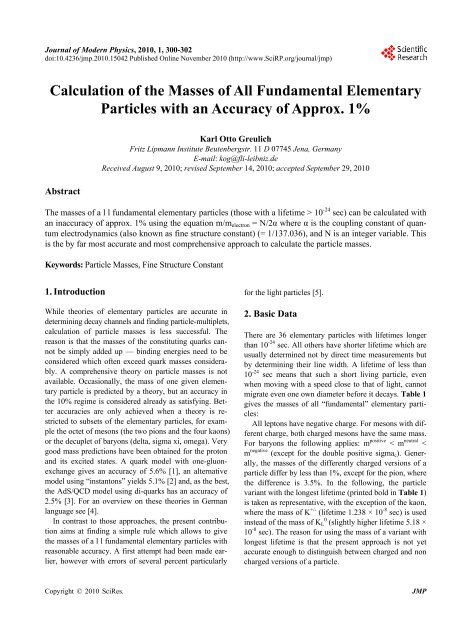

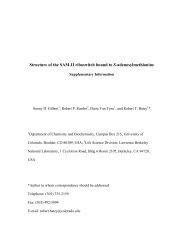
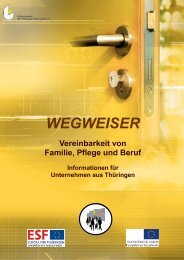
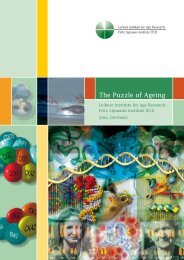

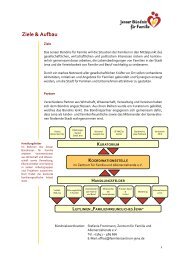



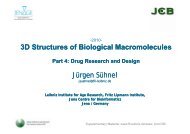
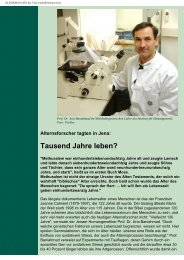

![Programm [pdf]](https://img.yumpu.com/20944039/1/184x260/programm-pdf.jpg?quality=85)
